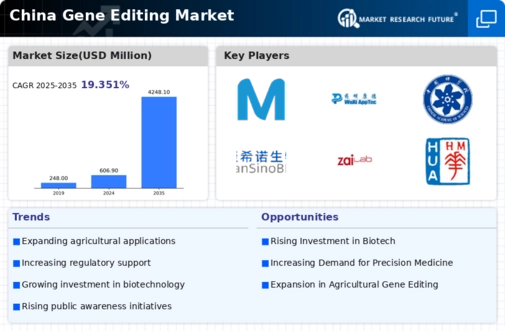Growing Agricultural Applications
The gene editing market in China is witnessing increased interest in agricultural applications, especially in developing genetically modified crops. With the increasing need for food security and sustainable agricultural practices, gene editing technologies are being utilized to enhance crop yields, improve resistance to pests, and reduce reliance on chemical fertilizers. The market for genetically modified crops in China is projected to reach $20 billion by 2025, reflecting a significant opportunity for gene editing technologies. Additionally, the adoption of gene editing in agriculture aligns with the government's goals of achieving self-sufficiency in food production. This trend not only supports the agricultural sector but also contributes to environmental sustainability, as gene editing can lead to more resilient crops that require fewer resources. Consequently, the agricultural applications of gene editing are likely to drive substantial growth in the gene editing market.
Rising Demand for Precision Medicine
The gene editing market in China is experiencing a notable surge in demand for precision medicine tailored to individual genetic profiles. This shift is driven by an increasing awareness of genetic disorders and the potential for gene editing technologies to provide targeted therapies. The market for precision medicine in China is projected to reach approximately $100 billion by 2025, reflecting robust growth. As healthcare providers and patients alike seek more effective treatment options, the gene editing market is positioned to play a crucial role in addressing these needs. Furthermore, advancements in CRISPR technology and other gene editing tools are enhancing the feasibility of personalized treatments, thereby further stimulating market growth. This trend underscores the importance of innovation in the gene editing market, as it aligns with the broader movement towards individualized healthcare solutions.
Increased Public Awareness and Acceptance
Public awareness and acceptance of gene editing technologies are on the rise in China, significantly impacting the gene editing market. As educational initiatives and media coverage increase, the general population is becoming more informed about the benefits and potential of gene editing. This growing awareness is fostering a more favorable perception of gene editing applications in healthcare and agriculture. Surveys indicate that approximately 70% of the population supports the use of gene editing for medical research and crop improvement. This acceptance is crucial for the market's expansion, as it encourages investment and innovation in gene editing technologies. Furthermore, as public understanding deepens, it is likely that regulatory frameworks will evolve to accommodate the growing demand for gene editing solutions. The increasing public support is thus a vital driver for the gene editing market, facilitating its integration into various sectors.
Government Support and Funding Initiatives
The Chinese government is actively promoting the gene editing market through various support and funding initiatives. Recognizing the potential of gene editing technologies to revolutionize healthcare and agriculture, the government has allocated substantial resources to research and development in this field. In recent years, funding for biotechnology research has increased significantly, with estimates suggesting an annual growth rate of over 15% in public investment. This financial backing not only facilitates innovation but also encourages collaboration between academic institutions and private enterprises. As a result, the gene editing market is likely to benefit from enhanced research capabilities and accelerated product development. The government's commitment to fostering a conducive environment for biotechnology advancements is expected to yield long-term benefits for the gene editing market, positioning China as a leader in this transformative industry.
Collaborations and Partnerships in Research
Collaborations and partnerships among academic institutions, research organizations, and private companies are becoming increasingly prevalent in the gene editing market in China. These alliances are essential for advancing research and accelerating the development of innovative gene editing technologies. By pooling resources and expertise, stakeholders can enhance their capabilities and drive breakthroughs in gene editing applications. Recent data suggests that collaborative research projects in biotechnology have increased by over 30% in the past few years, indicating a robust trend towards cooperation. Such partnerships not only facilitate knowledge sharing but also enable faster translation of research findings into practical applications. As the gene editing market continues to evolve, these collaborations are likely to play a pivotal role in shaping its future, fostering innovation, and ensuring that China remains at the forefront of gene editing advancements.

















Leave a Comment